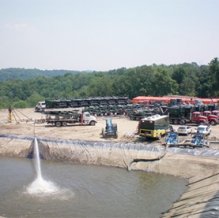Environmental Issues with fracking
Over the past decade, the oil and gas industry has fused two technologies – hydraulic fracturing and horizontal drilling – to unlock new supplies of fossil fuels in underground rock formations across the United States. “Fracking” has spread rapidly, leaving a trail of contaminated water, polluted air, and marred landscapes in its wake. In fact, a growing body of data indicates that fracking is an environmental and public health disaster in the making.
However, the true toll of fracking does not end there. Fracking’s negative impacts on our environment and health come with heavy “dollars and cents” costs as well. In this report, we document those costs – ranging from cleaning up contaminated water to repairing ruined roads and beyond. Many of these costs are likely to be borne by the public, rather than the oil and gas industry. And as with the damage done by previous extractive booms, the public may experience these costs for decades to come.
The case against fracking is compelling based on its damage to the environment and our health alone. To the extent that fracking does take place, the least the public can expect is for the oil and gas industry to be held accountable for the damage it causes. Such accountability must include up-front financial assurances sufficient to ensure that the harms caused by fracking are fully redressed.
Fracking damages the environment, threatens public health, and affects communities in ways that can impose a multitude of costs:
Drinking water contamination – Fracking brings with it the potential for spills, blowouts and well failures that contaminate groundwater supplies.
- Cleanup of drinking water contamination is so expensive that it is rarely even attempted. In Dimock, Pennsylvania, Cabot Oil & Gas reported having spent $109, 000 on systems to remove methane from well water for 14 local households, while in Colorado, cleanup of an underground gas seep has been ongoing for eight years at a cost of hundreds of thousands of dollars, if not more.
- The provision of temporary replacement water supplies is also expensive. Cabot Oil & Gas reported having spent at least $193, 000 on replacement water for homes with contaminated water in Dimock, Pennsylvania.
- Fracking can also pollute drinking water sources for major municipal systems, increasing water treatment costs. If fracking were to degrade the New York City watershed with sediment or other pollution, construction of a filtration plant would cost approximately $6 billion.
Health problems – Toxic substances in fracking fluid and wastewater – as well as air pollution from trucks, equipment and the wells themselves – have been linked to a variety of negative health effects.
- The National Institute of Occupational Safety and Health recently warned that workers may be at elevated risk of contracting the lung disease silicosis from inhalation of silica dust at fracking sites. Silicosis is one of a family of dust-induced occupational ailments that imposed $50 million medical care costs in the United States in 2007.
- Residents living near fracking sites have long suffered from a range of health problems, including headaches, eye irritation, respiratory problems and nausea – potentially imposing economic costs ranging from health care costs to workplace absenteeism and reduced productivity.
- Fracking and associated activities also produce pollution that contributes to the formation of ozone smog and particulate soot. Air pollution from gas drilling in Arkansas’ Fayetteville Shale region imposed estimated public health costs of more than $10 million in 2008.
Natural resources impacts – Fracking converts rural and natural areas into industrial zones, replacing forest and farm land with well pads, roads, pipelines and other infrastructure, and damaging precious natural resources.
- The clearance of forest land in Pennsylvania for fracking is projected to lead to increased delivery of nutrient pollution to the Chesapeake Bay, which already suffers from a vast nutrient-generated dead zone. The cost of reducing the same amount of pollution as could be generated by fracking would be approximately $1.5 million to $4 million per year.
- Gas operations in Wyoming have fragmented key habitat for mule deer and pronghorn, which are important draws for the state’s $340 million hunting and wildlife watching industries. The mule deer population in one area undergoing extensive gas extraction dropped by 56 percent between 2001 and 2010.
- Fracking also produces methane pollution that contributes to global warming. Emissions of methane during well completion from each uncontrolled fracking well impose approximately $130, 000 in social costs related to global warming.
Impacts on public infrastructure and services – Fracking strains infrastructure and public services and imposes cleanup costs that can fall on taxpayers.
- The truck traffic needed to deliver water to a single fracking well causes as much damage to local roads as nearly 3.5 million car trips. The state of Texas has approved $40 million in funding for road repairs in the Barnett Shale region, while Pennsylvania estimated in 2010 that $265 million would be needed to repair damaged roads in the Marcellus Shale region.





